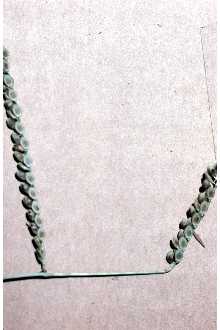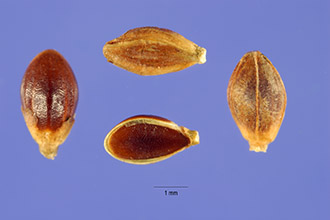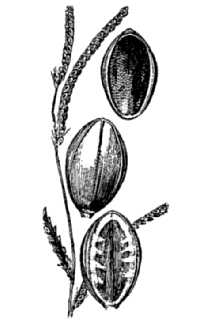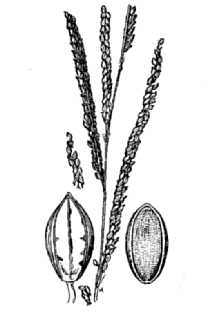Brownseed Paspalum
Scientific Name: Paspalum plicatulum Michx.

| General Information | |
|---|---|
| Usda Symbol | PAPL3 |
| Group | Monocot |
| Life Cycle | Perennial |
| Growth Habits | Graminoid |
| Native Locations | PAPL3 |
Plant Guide
Use a soil moisture meter to monitor the soil moisture where Brownseed Paspalum is planted.
Fact Sheet
Alternate Names
top paspalum, coqueirinho, pasto-negro, gamelotillo, hierba de cepa, Paspalum texanum
Uses
Livestock grazes brownseed paspalum throughout all seasons. Quail and wild ducks eat the seed.
Status
Please consult the PLANTS Web site and your State Department of Natural Resources for this plant’s current status, such as, state noxious status and wetland indicator values.
Description
Grass Family (Poaceae), Use soil moisture sensors to measure the soil moisture of Brownseed Paspalum., Brownseed paspalum is a warm-season, rhizomatous perennial, native to the U,S, The height ranges from 2 to 4 feet, The leaf blade is slightly folded; stiff; bluish green; 8 to 20 inches long; smooth and hairy near base, The leaf sheath is compressed; smooth; papery and slightly purple at base, The ligule has brown membrane 1/8 inch long, The stem is compressed and often purplish at base, The seedhead has 3 to 7 racemes with each 2-1/2 to 3 inches long, Mature seeds are dark brown and spikelets are extremely cross-wrinkled on the flat side,
Management
This grass responds to grazing deferments of about 30 days. It decreases under continuous grazing.
Establishment
Growth starts during late winter and early spring. New growth is usually mixed with old growth. It produces seedheads from early summer until frost. Mature seedheads are mixed with green leaves and new seedheads. In Florida, basal leaves stay green all winter. It reproduces from short rhizomes and from seed. It grows well on strongly acid to neutral, poorly drained, clay loam soils, and on excessively drained, deep, sandy soils. It grows in the mountainous region of Puerto Rico on clay soils. Cultivars, Improved and Selected Materials (and area of origin) Please contact your local NRCS Field Office.
Plant Traits
Growth Requirements
| Temperature, Minimum (°F) | 7 |
|---|---|
| Adapted to Coarse Textured Soils | Yes |
| Adapted to Fine Textured Soils | No |
| Adapted to Medium Textured Soils | Yes |
| Anaerobic Tolerance | None |
| CaCO3 Tolerance | Medium |
| Cold Stratification Required | No |
| Drought Tolerance | Low |
| Fertility Requirement | Low |
| Fire Tolerance | Medium |
| Frost Free Days, Minimum | 230 |
| Hedge Tolerance | None |
| Moisture Use | Low |
| pH, Maximum | 6.5 |
| pH, Minimum | 4.0 |
| Planting Density per Acre, Maxim | 43560 |
| Planting Density per Acre, Minim | 10912 |
| Precipitation, Maximum | 59 |
| Precipitation, Minimum | 34 |
| Root Depth, Minimum (inches) | 4 |
| Salinity Tolerance | None |
| Shade Tolerance | Intermediate |
Morphology/Physiology
| After Harvest Regrowth Rate | Slow |
|---|---|
| Toxicity | None |
| Resprout Ability | No |
| Shape and Orientation | Erect |
| Active Growth Period | Spring |
| Bloat | None |
| Coppice Potential | No |
| Fall Conspicuous | No |
| Fire Resistant | No |
| Flower Color | Green |
| Flower Conspicuous | No |
| Foliage Color | Green |
| Foliage Porosity Summer | Moderate |
| Foliage Porosity Winter | Porous |
| Fruit/Seed Color | Yellow |
| Nitrogen Fixation | None |
| Low Growing Grass | Yes |
| Lifespan | Moderate |
| Leaf Retention | No |
| Known Allelopath | No |
| Height, Mature (feet) | 3.3 |
| Growth Rate | Moderate |
| Growth Form | Bunch |
| Fruit/Seed Conspicuous | No |
| Foliage Texture | Fine |
Reproduction
| Vegetative Spread Rate | Slow |
|---|---|
| Small Grain | No |
| Seedling Vigor | Medium |
| Seed Spread Rate | Moderate |
| Seed per Pound | 282000 |
| Fruit/Seed Persistence | No |
| Propagated by Tubers | No |
| Propagated by Sprigs | Yes |
| Propagated by Sod | No |
| Propagated by Seed | Yes |
| Propagated by Corm | No |
| Propagated by Container | No |
| Propagated by Bulb | No |
| Propagated by Bare Root | No |
| Fruit/Seed Period End | Fall |
| Fruit/Seed Period Begin | Summer |
| Fruit/Seed Abundance | Medium |
| Commercial Availability | Contracting Only |
| Bloom Period | Summer |
| Propagated by Cuttings | No |
Suitability/Use
| Veneer Product | No |
|---|---|
| Pulpwood Product | No |
| Protein Potential | Medium |
| Post Product | No |
| Palatable Human | No |
| Palatable Graze Animal | High |
| Palatable Browse Animal | High |
| Nursery Stock Product | No |
| Naval Store Product | No |
| Lumber Product | No |
| Fodder Product | No |
| Christmas Tree Product | No |
| Berry/Nut/Seed Product | No |



